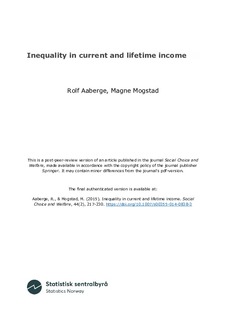| dc.contributor.author | Aaberge, Rolf | |
| dc.contributor.author | Mogstad, Magne | |
| dc.date.accessioned | 2019-02-28T10:27:01Z | |
| dc.date.available | 2019-02-28T10:27:01Z | |
| dc.date.issued | 2014-08-14 | |
| dc.identifier.citation | Aaberge, R., & Mogstad, M. (2015). Inequality in current and lifetime income. Social Choice and Welfare, 44(2), 217-230. doi:10.1007/s00355-014-0838-3 | nb_NO |
| dc.identifier.issn | 1432-217X | |
| dc.identifier.uri | http://hdl.handle.net/11250/2587997 | |
| dc.description | Authors have the right to disseminate their article's eOffprint (as a printout or by email) to their co-authors and research colleagues (for personal use by such colleagues). It is not allowed to distribute the eOffprint via a webpage. The eOffprint is for personal use only and shall not be self archived in electronic repositories. If you wish to self-archive your article, please use the accepted manuscript version for posting on your own website. You may further deposit the accepted manuscript version in any repository, provided it is only made publicly available 12 months after official publication or later and provided acknowledgement is given to the original source of publication and a link is inserted to the published article on Springer's website. The link must be accompanied by the following text: "The final publication is available at https://doi.org/10.1007/s00355-014-0838-3 | nb_NO |
| dc.description.abstract | To gauge inequality in living standards, the distribution of lifetime income is likely to be more relevant than the distribution of current income. Yet, empirical studies of income inequality are typically based on observations of income for one or a few years. In this paper, we exploit a unique data set with nearly career-long income histories to assess the role of so-called life-cycle bias in empirical analysis of income inequality that uses current income variables as proxies for lifetime income. We find evidence of substantial life-cycle bias in estimates of inequality based on current income. One implication is that cross-sectional estimates of income inequality are likely to be sensitive to the age composition of the sample. A decomposition of the life-cycle bias into income mobility and heterogeneous profiles reveal the importance of two explanations that have been put forth to explain the disagreement between current and lifetime inequality. | nb_NO |
| dc.language.iso | eng | nb_NO |
| dc.publisher | Springer | nb_NO |
| dc.rights | Navngivelse-Ikkekommersiell 4.0 Internasjonal | * |
| dc.rights.uri | http://creativecommons.org/licenses/by-nc/4.0/deed.no | * |
| dc.subject | Income inequality | nb_NO |
| dc.subject | Gini coefficient | nb_NO |
| dc.subject | Lorenz Curve | nb_NO |
| dc.subject | Inequality measure | nb_NO |
| dc.subject | Current income | nb_NO |
| dc.subject | Inntektsulikhet | nb_NO |
| dc.title | Inequality in current and lifetime income | nb_NO |
| dc.type | Journal article | nb_NO |
| dc.type | Peer reviewed | nb_NO |
| dc.description.version | acceptedVersion | nb_NO |
| dc.rights.holder | Springer | nb_NO |
| dc.subject.nsi | VDP::Samfunnsvitenskap: 200::Økonomi: 210 | nb_NO |
| dc.source.pagenumber | 217-230 | nb_NO |
| dc.source.volume | 44 | nb_NO |
| dc.source.journal | Social Choice and Welfare | nb_NO |
| dc.source.issue | 2 | nb_NO |
| dc.identifier.doi | https://doi.org/10.1007/s00355-014-0838-3 | |

